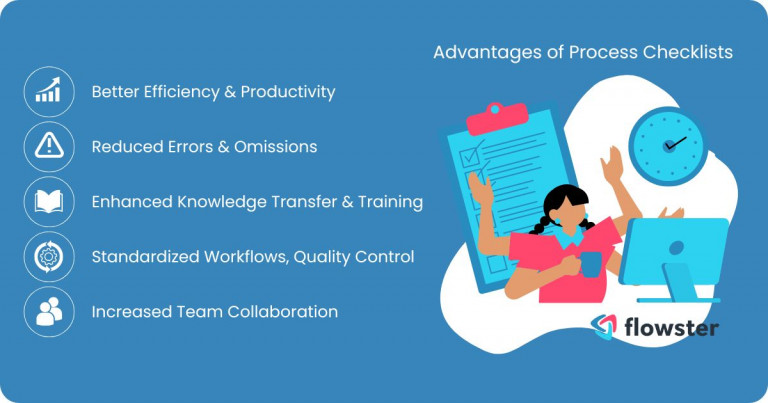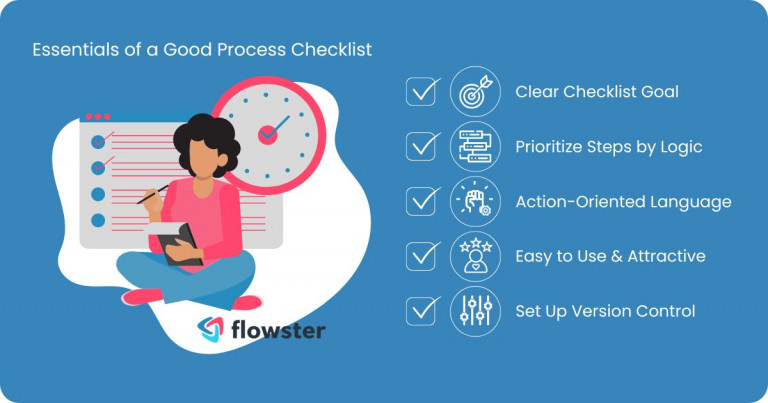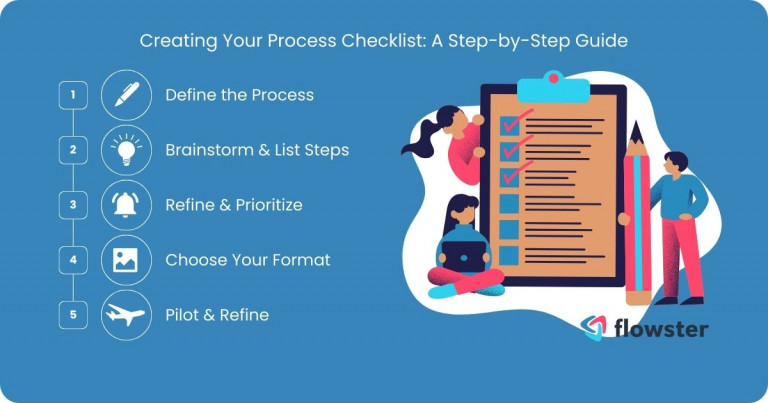Have you ever meticulously planned a social media campaign, only to realize on launch day that you forgot to schedule all the posts? Or perhaps you spent hours training a new employee, but a crucial step got lost in the shuffle? We’ve all been there. Fortunately, there’s a simple yet powerful tool that can prevent these frustrating oversights: the process checklist.
A process checklist is a detailed list of steps outlining a specific task or workflow. It acts as a roadmap, ensuring every crucial step gets completed in the right order. But process checklists offer much more than just preventing forgotten tasks. They are the secret weapon for boosting efficiency, maintaining consistency, and achieving flawless results across any project.
Article Outline
Benefits of Using Process Checklists:
Let’s delve deeper into the advantages process checklists bring to the table. Here’s how they can revolutionize your workflow:
- Improved Efficiency & Productivity: By streamlining tasks and eliminating the need to recall every step, process checklists free up valuable mental space. This allows you to focus on higher-level thinking and complete tasks quicker.
- Reduced Errors & Omissions: No more scrambling to remember forgotten details. Process checklists ensure every crucial step gets completed, minimizing errors and omissions that can derail projects.
- Enhanced Knowledge Transfer & Training: Checklists act as a transferable knowledge base. They facilitate the smooth onboarding of new team members and ensure everyone follows the same standardized procedures.
- Standardized Workflows & Quality Control: Process checklists guarantee consistency in how tasks are completed. This leads to standardized workflows and improved quality control across all projects.
- Increased Team Collaboration: Clear and defined procedures outlined in checklists promote better communication and collaboration within teams. Everyone is on the same page, leading to smoother project execution.
Who Can Benefit From Process Checklists?
The beauty of process checklists lies in their universal applicability. Whether you’re a:
- Freelancer: Streamline your client onboarding process, project management, and content creation.
- Entrepreneur: Ensure consistent quality control in your product development or customer service.
- Business (of all sizes): Standardize workflows across departments, improve training efficiency, and minimize errors.
Process checklists are a powerful tool for anyone seeking to streamline tasks, boost productivity, and achieve consistent results. In the next section, we’ll delve into the anatomy of a powerful process checklist, equipping you with the knowledge to create your own!

The Anatomy of a Powerful Process Checklist
Now that we understand the immense value process checklists offer, let’s explore what makes them truly effective. A well-crafted process checklist isn’t just a random list of tasks; it’s a meticulously designed roadmap that guides users through a specific process with clarity and efficiency. Here’s a breakdown of the key elements that contribute to a powerful process checklist:
Crafting Effective Checklists:
- Defining the Scope: Every process checklist should have a clear and well-defined purpose. The first step is to identify the specific process the checklist addresses. This helps ensure the list focuses on the relevant steps and avoids unnecessary clutter.
- Prioritization: Not all steps within a process are created equal. When crafting your process checklist, prioritize the sequence of steps based on logical flow. Crucially important tasks should be prominently positioned to ensure they don’t get overlooked.
- Wording & Clarity: Clear communication is paramount. Use concise, action-oriented language that’s easy to understand. Instead of vague instructions like “handle content,” opt for specific verbs like “review content,” “edit content,” and “upload content.” This clarity eliminates ambiguity and ensures everyone using the checklist is on the same page.
- Formatting for Readability: Presentation matters! Utilize bullet points, checkboxes, and clear headings to make your process checklist visually appealing and easy to navigate. This allows users to quickly scan and identify the steps they need to complete.
- Version Control: Processes evolve over time. Establish a system for version control within your process checklist. This allows you to track changes, maintain accuracy, and ensure everyone is using the most up-to-date version.
Advanced Checklist Techniques:
While the basic elements are essential, process checklists can be further enhanced with advanced techniques to cater to complex workflows:
- Implementing Decision Points: Processes sometimes involve conditional steps. For example, a social media post may require additional steps depending on the content type. Include branching options within your checklist to guide users through these conditional scenarios.
- Assigning Roles & Responsibilities: For team-based workflows, clearly specify who owns each task on the checklist. This promotes accountability and ensures everyone knows their part in the process.
- Adding Optional Steps: Not every situation requires the same exact steps. Include optional steps (perhaps grayed out or bracketed) within your checklist for specific scenarios, allowing users to customize the process as needed.
- Integrating Visual Aids: For complex steps that require visual guidance, consider incorporating screenshots or diagrams directly into your process checklist. This can be particularly helpful for technical procedures or unfamiliar software interfaces.
By incorporating these elements, you can create a process checklist that is not just informative but also user-friendly, adaptable, and highly effective. In the next section, we’ll dive into the practical steps of crafting your own customized process checklist!

Creating Your Process Checklist: A Step-by-Step Guide
Now that we’ve explored the key features of a powerful process checklist, let’s get hands-on and build your own! Here’s a step-by-step guide to walk you through the creation process:
Step 1: Define the Process
The first step is to identify the specific task or workflow you want to streamline with a process checklist. Is it your social media content creation process? Onboarding new team members? Perhaps a recurring customer service procedure? Clearly defining the target process ensures your checklist focuses on the relevant steps and delivers maximum value.
Step 2: Brainstorm & List Steps
Break down the chosen process into individual, actionable steps. Think critically about every stage involved, from initiation to completion. Don’t be afraid to get detailed – the more comprehensive your list, the less likely you are to miss crucial aspects.
Step 3: Refine & Prioritize
Once you have a comprehensive list, it’s time to refine and prioritize. Sequence the steps in a logical order that reflects the natural flow of the process. Identify and highlight critical tasks that absolutely cannot be missed. This prioritization ensures a smooth and efficient workflow.
Step 4: Choose Your Format
There’s no one-size-fits-all approach to process checklist formats. Consider the context and choose a format that best suits your needs and preferences. Digital tools like Google Sheets or task management software offer easy editing, sharing, and version control. Alternatively, physical formats like paper checklists or laminated cards can be convenient for on-the-go use.
Step 5: Pilot & Refine
Your initial process checklist is a draft, not a finished product. The real test comes with putting it into action. Pilot your checklist with a small group of users and gather feedback on its clarity, usability, and effectiveness. This feedback allows you to refine your checklist, ensuring it truly optimizes the target process.
By following these steps, you’ll be well on your way to crafting a customized process checklist that streamlines your workflow, minimizes errors, and empowers you to achieve consistent results. In the next section, we’ll explore how to effectively integrate process checklists into your daily routine for maximum impact.

Using Process Checklists Effectively
Having a well-crafted process checklist is only half the battle. To unlock its full potential, you need to effectively integrate it into your workflow. Here are some key strategies for using process checklists effectively:
- Integration & Accessibility: Make sure your process checklists are readily available to everyone who needs them. Store them in easily accessible locations like project management tools, shared drives, or company wikis. This ensures everyone using the process has quick access to the most up-to-date version of the checklist.
- Encouraging Checklist Adoption: Don’t expect blind adoption. Promote the benefits of process checklists to your team or colleagues. Highlight how they can save time, improve accuracy, and ensure consistent results. Additionally, provide training on how to effectively use and navigate the checklists. The more invested users are in the system, the more effective it will be.
- Regular Review & Updates: Processes evolve over time. Schedule regular reviews of your process checklists to ensure they remain accurate and reflect any changes in the workflow. This might involve soliciting feedback from users or revisiting the process itself to identify potential improvements. Regular updates guarantee your process checklists continue to deliver optimal value.
By following these strategies, you can transform your process checklists from static documents into dynamic tools that empower your team and drive consistent success. In the concluding section, let’s summarize the key takeaways and discuss the vast potential of process checklists.
Flowster's AI-Driven Automation
The Power is in Your Hands: Unleash the Potential of Process Checklists
Throughout this guide, we’ve explored the power of process checklists. We’ve seen how these simple yet effective tools can streamline workflows, minimize errors, and ensure consistent results across any project or task. By incorporating clear instructions, logical sequencing, and user-friendly design, process checklists empower you to achieve optimal efficiency and quality control.
Ready to take your projects to the next level? Don’t wait any longer! Start creating your own process checklists today. Identify a repetitive task or workflow that could benefit from a structured approach and follow the step-by-step guide outlined earlier. Remember, the beauty of process checklists lies in their customizability. Tailor them to your specific needs and preferences to maximize their impact.
Jumpstart Your Process Checklist Creation
Flowster Marketplace offers a variety of free downloadable templates, including process checklist templates and other workflow templates. These resources provide a strong foundation for building your customized checklists and streamlining your work.
For those seeking a more comprehensive solution, Flowster also offers “Done-for-You” services. Our team of experts can craft customized process checklists specifically tailored to your unique workflows and processes.
Let process checklists become your secret weapon for achieving peak productivity and flawless execution. Embrace their power, and watch your projects soar!




